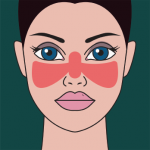
Andarey_Popov / shutterstock.coma
“It’s crazy! None of the pictures online look like me!” a young Black woman with systemic lupus earythematosus (SLE) exclaimed. We could only affirm her observation and agree that it was unfair.
Like many patients with SLE, our patient was diagnosed at a young age and suffered severe complications that required kidney transplantation before her 30th birthday. Patients with skin of color (SOC) have been shown to experience worse health outcomes than their white counterparts, a disparity that is amplified among patients with SLE and rheumatoid arthritis (RA).1 Despite this patient’s risk for worse outcomes, she found herself underrepresented in images published to depict her diagnosis and educate patients, caregivers and healthcare practitioners about her condition.
This experience complements research demonstrating that patients with SOC are underrepresented in medical resources. This absence extends to published images, as well as information about how diagnoses may manifest differently in different skin types. Materials from general medical education, dermatology and plastic surgery disproportionately represent white patients in their content.2-4 This year, two studies published in Arthritis Care & Research show rheumatology resources also underrepresent SOC.
In a review of images for musculoskeletal and rheumatic diseases published in major rheumatology textbooks, UpToDate and The New England Journal of Medicine, Strait et al. revealed a publishing bias for what they categorized as “light” skin tones.5
Rana et al. expanded on this work through the collection of images specifically representing SLE in textbooks, journals and online image libraries within rheumatology, dermatology and internal medicine, as well as a comprehensive search of Google Images, with similar results.6 Because patients with SOC who also have SLE or RA experience the most disparate health outcomes of rheumatic diseases, Strait et al. then performed a post hoc comparison of skin color within images of SLE or RA to estimate the number of patients with these conditions in the U.S. population. The studies showed the underrepresentation of SOC is most notable among patients with SLE or RA and in photos on Google Images.5,6
Effects
This publication bias contributes to poorer health outcomes observed in this patient population. Resources help providers develop clinical heuristics, but when SOC is excluded from these materials, practitioners cannot easily achieve expertise caring for conditions in patients with SOC. Providers report lower confidence managing cutaneous pathology in SOC.7 In conditions like SLE and RA, in which patients with SOC are vulnerable to misdiagnosis, it is essential that clinicians be able to recognize disease manifestations in all skin tones to facilitate early diagnosis and treatment.
The lack of SOC in published images also affects relationships between patients and clinicians. Patients recognize their exclusion, especially among easily accessible online images, and may interpret this bias as though the profession of medicine and, by corollary, individual providers place less value on their well-being than that of white patients who are more prominently depicted. This may contribute to a sense of mistrust in the healthcare system and the perception that patients receive worse care from practitioners of a different race or ethnicity.8
The representation of skin tones in medical education resources also affects practitioners in training and healthcare environments. A medical student who identifies as Black noticed the materials presented in her classes excluded patients with SOC.9 As a result, she felt “othered,” as though skin color separated her from her peers, as well as the patients she was being trained to treat. This demonstrates that medical resources can contribute to an exclusionary culture.
Action Needed
Medical publishers can correct the underrepresentation of SOC in their materials, addressing one root cause for health inequity. Strait et al. call for improved representation of all skin tones in educational resources.5
The ACR dedicated this year’s Image Competition to SOC to increase representation and enhance practitioner learning.10 This initiative, combined with online modules focused on cutaneous findings in a variety of skin tones, begins to address providers’ educational needs.11
The development of SOC atlases has expanded practitioners’ access to images, and current initiatives seek to integrate SOC images in all educational texts, thereby standardizing their publication in resources.6,12
The delivery of high-quality care to all patients enhances clinical learning. In response to documented gaps in training and disparate comfort levels caring for patients across a spectrum of skin colors, dermatologists have created clinics dedicated to SOC.13 These clinics work toward improving health outcomes for patients, as well as augmenting the educational experience. When practitioners and educators partner with providers with expertise diagnosing and treating patients with SOC, they build relationships that reinforce the medical profession’s commitment to equitable patient care.
Bottom Line
The underrepresentation of SOC in medical resources hinders practitioners’ knowledge and clinical skills, perpetuating the marginalized status of vulnerable patients. Medical education contributes to these health disparities, but it also represents a way to help remedy them.
Lisa Zickuhr, MD, is an assistant professor of medicine, director of the rheumatology curricula and associate director of the medicine clerkship at Washington University School of Medicine, St. Louis, Mo.
Amaad Rana, MD, is a first-year rheumatology fellow at Washington University School of Medicine.
Heather A. Jones, MD, is an assistant professor of medicine and associate program director of the Dermatology Training Program at Washington University School of Medicine.
References
- Molokhia M, McKeigue P. Risk for rheumatic disease in relation to ethnicity and admixture. Arthritis Res. 2000;2(2):115–125.
- Louie P, Wilkes R. Representations of race and skin tone in medical textbook imagery. Soc Sci Med. 2018 Apr;202:38–42.
- Adelekun A, Onyekaba G, Lipoff JB. Skin color in dermatology textbooks: An updated evaluation and analysis. J Am Acad Dermatol. 2021;84(1):194–196.
- Massie JP, Cho DY, Kneib CJ, et al. Patient representation in medical literature. Plast Reconstr Surg Glob Open. 2019 Dec 26;7(12):e2563.
- Strait A, Graf J, Margaretten M, et al. Race, ethnicity and disparities in rheumatology educational materials. Arthritis Care Res (Hoboken). 2021 Mar 25.
- Rana A, Witt A, Jones H, et al. The representation of skin colors in images of patients with lupus erythematosus. Arthritis Care Res (Hoboken). 2021 May 31. Epub ahead of print.
- Rodrigues MA, Ross AL, Gilmore S, Daniel BS. Australian dermatologists’ perspective on skin of colour: Results of a national survey. Australas J Dermatol. 2018 Feb;59(1):e23–e30.
- Gorbatenko-Roth K, Prose N, Kundu RV, Patterson S. Assessment of Black patients’ perception of their dermatology care. JAMA Dermatology. 2019;155(10):1129–1134.
- Nolen LS. How medical education is missing the bull’s-eye. N Engl J Med. 2020 Jun 25;382(26):2489–2491.
- Image Competition. American College of Rheumatology.
- Elston CA, Elston DM. Identifying lesions on skin of color. Medscape. 2021 May 10.
- Kelly AP, Taylor SC, Lim HW, Serrano AMA. Taylor and Kelly’s Dermatology for Skin of Color, 2nd ed. New York: McGraw-Hill Education; 2016.
- Tull RZ, Kerby E, Subash JJ, McMichael AJ. Ethnic skin centers in the United States: Where are we in 2020? J Am Acad Dermatol. 2020 Dec;83(6):1757–1759.

